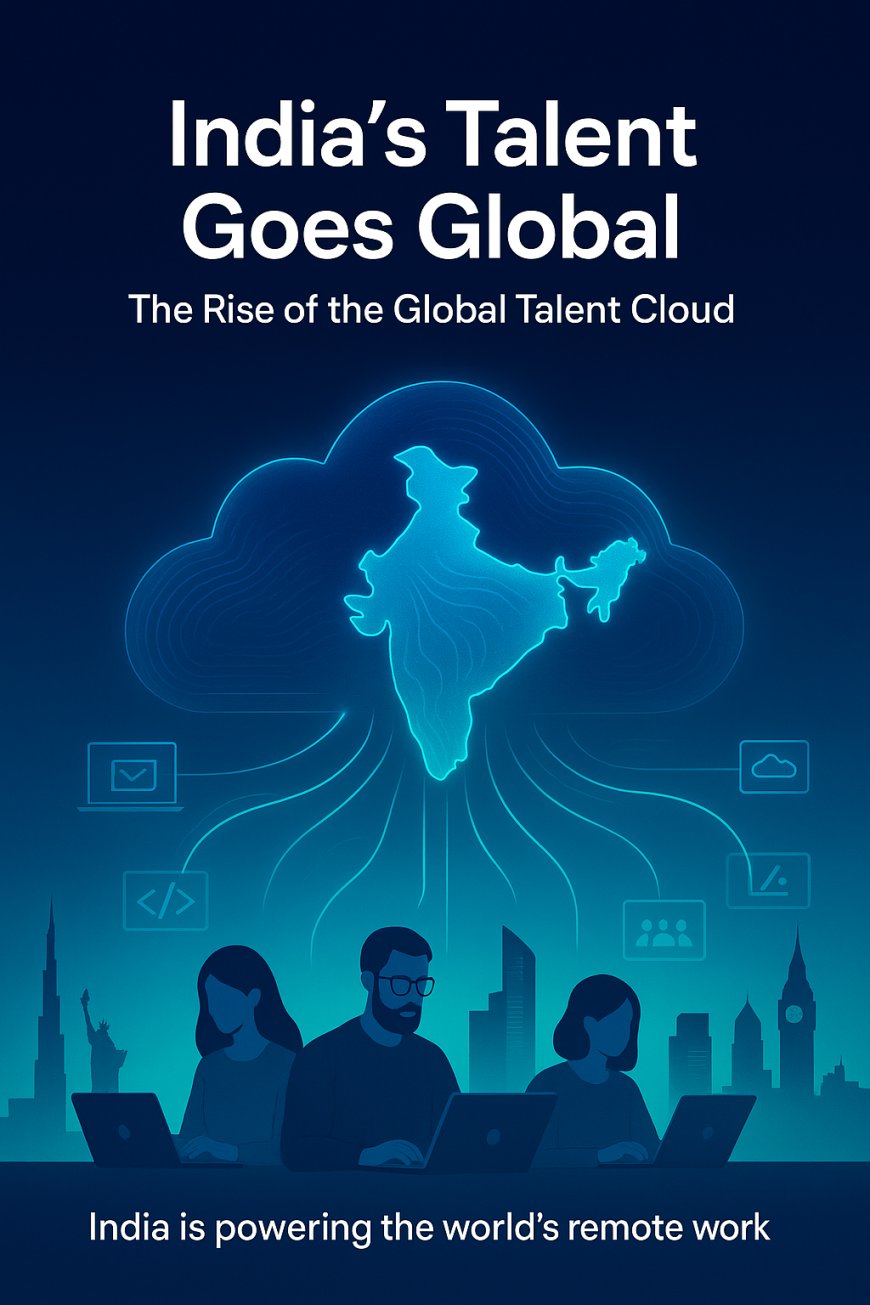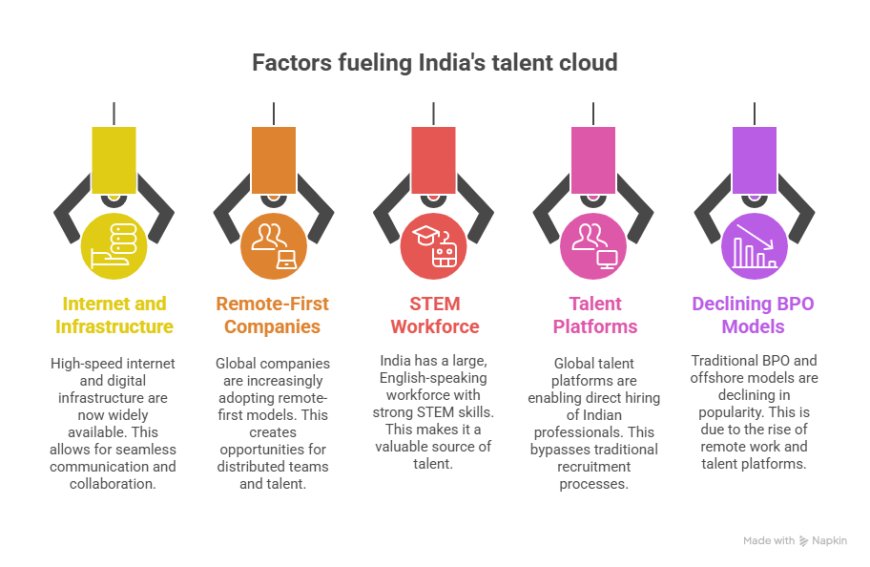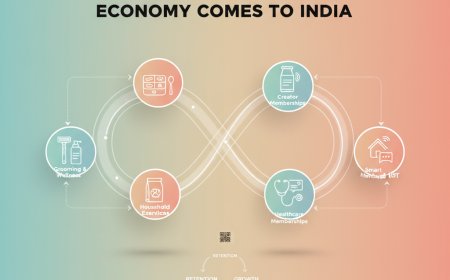India’s Talent Goes Global as Remote-First Hiring Takes Over
India is emerging as a global talent cloud as companies hire Indian professionals directly. Explore the rise of remote-first work, freelancing, and distributed teams.

A silent but massive shift is underway in the global workforce. The pandemic didn’t just normalize remote work—it accelerated a complete rewrite of how companies hire, collaborate, and build teams. As offices dissolved into Zoom rooms, global hiring horizons expanded overnight.
And in this new reality, India has emerged as the world’s largest, most dynamic “Global Talent Cloud.”
For decades, India was synonymous with outsourcing—large IT services firms acting as intermediaries between global companies and Indian talent. But that era is evolving fast. Today, businesses across the US, Europe, the Middle East, and Southeast Asia are hiring Indian professionals directly—engineers, designers, product managers, growth marketers, analysts, and creators.
The shift is profound:
- Earlier: “We outsource to a company in India.”
- Now: “We hire a remote team member from India.”
This transformation is powered by a global mindset change:
Talent is no longer defined by location, but by contribution.
Companies care less about where people live and more about how fast they can contribute.
For Indian professionals, this has unlocked global opportunities without migration.
For companies, it has opened access to world-class talent at competitive costs.
Core idea:
India today represents a scalable, borderless, always-on talent cloud—plug-and-play human capital powering global companies at startup speed.
What’s Fueling This Shift?
India’s rise as a global talent cloud is not accidental—it’s the result of powerful macro shifts converging at the right time. Here are the forces reshaping the global talent landscape:

1. Ubiquitous high-speed internet + digital infrastructure
Affordable broadband, widespread 4G/5G, and digital tools (UPI, DigiLocker, Aadhaar) have enabled millions to work from anywhere—in cities, towns, or remote regions. India’s digital rails have made remote work operationally seamless.
2. Remote-first global companies looking for distributed teams
Post-pandemic, thousands of startups and enterprises have shifted to remote or hybrid models. Hiring globally is now standard practice.
India offers a time-zone advantage across APAC, the Middle East, and parts of Europe—making distributed workflows smooth.
3. India’s large, English-speaking, STEM-heavy workforce
With over 4 million engineers and millions more in design, data, and digital roles, India is uniquely positioned for global hiring.
English fluency + cultural adaptability = frictionless collaboration.
4. Rise of global talent platforms enabling direct hiring
Platforms like:
- Upwork, Fiverr → freelancing
- Toptal, Contra → elite global talent
- Deel, Rippling, Remote.com → global payroll, compliance, cross-border hiring
have made it incredibly easy for companies to hire Indian professionals directly without intermediaries.
5. Decline of traditional BPO/offshore models
Companies want:
- transparency,
- agility,
- direct control,
- and high-skill roles.
This is pushing them toward direct contracts instead of hiring through large outsourcing firms.
Indian professionals now get better pay, better autonomy, and direct relationships with global teams.
India’s Remote Workforce Boom
India is no longer just exporting IT services — it’s exporting individual talent at scale. A new generation of Indian professionals is building global careers without ever leaving their hometowns.
The shift is visible everywhere:
• Freelancers, consultants, remote developers, and independent creators are growing faster than any traditional employment segment.
• Indian engineers, designers, PMs, marketers, and analysts now work directly with startups across the US, Europe, the Middle East, and Southeast Asia — often as core team members, not outsourced support.
• A “Global from Day 1” mindset is emerging among students and early-career professionals who see the world as their job market.
• Hiring platforms and digital ecosystems such as GitHub (open-source visibility), LinkedIn (global job filters), AngelList (startup roles), and Naukri Abroad are making global opportunities discoverable and accessible.
Perhaps the most significant driver?
Salary arbitrage is becoming salary opportunity.
Talented professionals can earn global-level incomes while living in India, creating a new class of financially mobile remote workers. This combination of global exposure + local cost advantage has unlocked unprecedented career mobility.
India is quietly becoming the world’s largest, most dynamic remote talent hub — not by outsourcing, but by individuals plugging directly into global innovation ecosystems.
Talent Archetypes in India’s Global Cloud
India’s global-ready talent no longer fits into a single bucket. A diverse set of professional archetypes is powering the country’s rise as a borderless talent engine.

a. Remote Software Engineers & Product Teams
India’s strongest export continues to be technical talent — but now, it’s going direct.
Full-stack developers, AI/ML engineers, data scientists, cloud architects, and DevOps specialists are being hired directly by global startups and enterprises.
Many work asynchronously, using GitHub, Jira, Slack, and Notion to ship production-ready code from anywhere in India.
Entire remote product pods — engineers + designers + QA — are being assembled for global companies.
b. Creative Talent
India’s creative talent ecosystem has exploded.
UI/UX designers, brand strategists, illustrators, 2D/3D artists, copywriters, video editors, and content producers are building portfolios that attract global clients.
They thrive on platforms like Behance, Dribbble, Fiverr, and Contra — designing for global brands while operating out of studios in Bangalore, Goa, Jaipur, and Kochi.
The global demand for creative storytelling has put Indian creatives on an international stage.
c. No-Code / Automation Specialists
A new category is rising fast.
Experts in Airtable, Zapier, Make, Bubble, Webflow, Retool, and Glide are powering automation, MVPs, and workflow systems for global SMEs.
They operate like micro-agencies — fast, efficient, and infinitely scalable.
With startups prioritizing speed, these specialists have become indispensable for rapid prototyping and automation without heavy engineering teams.
d. Fractional Leaders
High-skill leadership is going global, too.
India is witnessing a surge of fractional CTOs, CMOs, CFOs, and product leaders who work with multiple companies simultaneously.
Global startups love fractional leadership because it provides senior expertise without committing to a full-time salary.
These leaders bring years of experience, cross-industry exposure, and the ability to plug into distributed teams instantly.
e. Independent Creators
The creator economy is now part of India’s talent cloud.
Writers, educators, podcasters, newsletter authors, YouTubers, community builders, and digital coaches are selling globally through courses, memberships, templates, and content.
Platforms like Gumroad, Kajabi, Patreon, Substack, and YouTube have given them direct access to global audiences.
Many are earning more than traditional jobs — with total independence and global reach.
Why Global Companies Prefer India’s Talent Cloud
The world isn’t just hiring from India because it’s affordable — they’re hiring because it’s effective. India has quietly built the perfect conditions for a borderless workforce, making it one of the most attractive global talent pools today.
• Cost-effective, yet high-quality output
India offers a rare combination: globally competitive skills at a cost structure that works for startups and enterprises alike. But the shift today is less about cost-saving and more about value density — world-class work from skilled professionals who understand global standards.
• Time-zone compatibility across APAC, Europe, and the Middle East
India sits in a sweet spot. Professionals can collaborate synchronously with APAC mornings, overlap with Europe through the afternoon, and sync with the Middle East and even parts of the US in the evenings.
This makes India a natural hub for distributed teams that operate across continents.
• A powerful technical education pipeline
India’s talent cloud is fueled by a deep bench of technical education:
IITs, NITs, IIITs, and top private universities produce elite engineering talent annually. Bootcamps, upskilling programs, and online learning platforms are creating a massive second wave of job-ready developers, designers, and analysts.
This pipeline ensures a continuous supply of globally competitive talent.
• Cultural adaptability + English fluency
Indian professionals are uniquely positioned to work with global teams because of their cultural flexibility, collaborative mindset, and strong English communication skills.
This reduces friction and improves integration compared to other global markets.
• Plug-and-play remote infrastructure
Platforms like Deel, Papaya Global, Remote.com, Rippling, Multiplier, and various PEO/EOR services have made hiring in India as simple as hiring domestically.
Global companies can onboard Indian talent in days, manage payroll compliantly, and offer benefits without opening local entities.
This ease of hiring accelerates India’s integration into the global remote economy.
India is no longer just “an option” — it’s becoming the default choice for globally distributed teams.
Direct Hiring vs Outsourcing — The Big Shift
For decades, India’s connection to global work was defined by outsourcing giants. But that model is being disrupted — not by technology alone, but by new expectations from both companies and talent.
The Old Model: Renting Teams Through Outsourcing Firms
This legacy system was built on intermediaries — IT services companies, BPOs, consulting firms.
Companies didn’t hire Indian talent; they hired access to Indian talent.
Professionals worked behind layers of corporate structure, processes, billing rates, and limited autonomy.
It was efficient, but it wasn’t personal — or empowering.
The New Model: Direct Global Hiring
We’re now in a world where companies want individuals, not intermediaries.
• Direct contracts with Indian engineers, designers, PMs, and operators
Global businesses recruit Indian talent the same way they hire domestically — through interviews, portfolio reviews, trial projects, and cultural fit.
This creates tighter integration and higher accountability.
• Global payroll platforms are simplifying everything
Tools like Deel, Remote.com, and Rippling handle contracts, compliance, payroll, and benefits — removing the headache of international hiring.
Startups can now hire a developer in Bangalore or a designer in Kochi as easily as someone in Berlin or Toronto.
• More transparency, independence, and significantly better pay for Indian professionals
Direct hiring eliminates the layers of margins added by outsourcing firms.
Professionals earn more, companies pay less, and both enjoy clearer communication and control.
• Rise of “Talent-as-a-Service”
A new operating model is emerging — highly skilled individuals offering their expertise on flexible, subscription-like engagement models.
It’s not headcount; it’s capability on demand.
This mirrors how cloud computing works — elastic, scalable, and efficient.
The shift from outsourcing to direct global talent engagement is one of the biggest transformations in India’s work ecosystem — and it’s redefining how global companies build and scale teams.
The Rise of India’s Freelancing & Creator Economy
India’s talent cloud isn’t just about remote developers and product teams — it’s also powered by a fast-growing wave of freelancers, solopreneurs, and creators building global careers from their laptops.
• Indian freelancers are dominating global talent platforms
Across Upwork, Fiverr, Toptal, Freelancer.com, and Contra, Indian freelancers consistently rank among the top earners in software development, design, marketing, automation, and analytics.
Many operate as micro-agencies, serving clients in the US, Europe, Australia, and the Middle East — earning in USD/EUR while living in Tier-1, 2, and even Tier-3 cities.
• Indian creators are selling globally — not just locally
A new generation of Indian creators is building digital-first businesses by selling:
– Online courses
– Community memberships
– Templates and digital assets
– Premium newsletters
– Cohort-based programs
– Coaching & consulting sessions
They’re using global platforms like Gumroad, Kajabi, Teachable, Substack, Patreon, and Circle to reach international customers.
• Remote-first creators redefining India’s digital influence
YouTubers, educators, podcasters, video editors, and digital product makers are creating content for global audiences.
This “creator export economy” is turning individual Indian professionals into global brands, often with followers across continents.
• Work is becoming borderless — and so is opportunity
From Bangalore to Bhopal, Hyderabad to Himachal, thousands of Indians now run location-independent careers, working for global clients and customers entirely online.
India’s freelancing and creator economy is not a side story — it’s a central pillar of the country’s emerging global talent identity.
Challenges India Must Overcome
India’s rise as a global talent cloud is undeniable — but several systemic challenges still need to be addressed to unlock its full potential.
• Uneven access to stable high-speed internet
While metros enjoy world-class connectivity, many Tier-2 and Tier-3 cities still face unreliable broadband.
This creates inequality in who can truly participate in the global remote economy.
• Skill gaps in manager-level and leadership roles
India produces vast numbers of engineers, but not enough globally experienced project managers, product leaders, delivery heads, and remote team leads.
The next growth wave requires managerial and strategic talent, not just technical.
• Need for global client management capabilities
Remote work isn’t just about technical skills — it demands:
– Clear communication
– Project ownership
– Time-zone discipline
– Cross-cultural collaboration
– Professional documentation
Many professionals still need training in these “global remote work skills.”
• Regulatory clarity around foreign income
Freelancers and remote workers often struggle with confusing processes related to FIRC, GST applicability, TDS, income reporting, and forex conversions.
Simplifying compliance for international earnings would accelerate India’s talent exports.
• Growing competition from emerging global talent hubs
Countries like the Philippines, Vietnam, Bangladesh, Nigeria, and LATAM nations are rapidly investing in remote talent development.
India must continuously upgrade skills and infrastructure to stay ahead.
India’s challenges are real — but solvable. And addressing them will determine how large and influential the country’s global talent cloud becomes in the next decade.
The Future: India as the World’s Distributed Workforce Engine
India’s transformation into a global talent cloud is only the beginning. Over the next decade, India is poised to become the world’s largest distributed workforce engine, powering companies across every time zone.
• Fractional work is becoming mainstream
The idea of working part-time for multiple companies — as a fractional CTO, designer, product manager, marketer, analyst, or operations lead — is gaining massive traction.
Global companies increasingly prefer flexible, outcome-oriented engagement models, and Indian professionals are perfectly positioned to lead this shift.
• India will supply millions to the global talent grid by 2030
With rising digital literacy, powerful remote-work tools, and widespread adoption of global hiring platforms, India could contribute 15–20% of the world’s remote-first digital workforce within the next decade.
This includes developers, designers, educators, creators, virtual assistants, and automation specialists.
• New opportunities for rural and Tier-2/3 India
Remote work unlocks participation from cities that were previously excluded from global opportunities.
A designer in Coimbatore, a developer in Indore, a video editor in Guwahati, a marketer in Surat — all can now work globally without relocating.
This shift has the potential to redistribute economic power, reduce migration pressure on metros, and elevate regional prosperity.
• India-led platforms and marketplaces will emerge
The next frontier is India building its own:
– Global freelance platforms
– Remote hiring infrastructures
– Skill-development networks
– Virtual coworking and collaboration tools
– AI-driven talent-matching engines
Just as India revolutionized digital payments with UPI, it could soon redefine global talent infrastructure with homegrown remote-work ecosystems.
• From outsourcing hub → to independent talent powerhouse
The old model relied on large outsourcing firms exporting services.
The new model is a decentralized ecosystem of millions of independent professionals exporting skills, creativity, and digital products directly.
This transition marks the rise of India as a sovereign talent economy — agile, globally integrated, and self-driven.
India isn’t just filling global jobs.
It is becoming the backbone of the world’s distributed workforce.
Conclusion: Talent Without Borders
India’s workforce is no longer defined by office locations, tech parks, or outsourcing contracts. It is defined by skills, speed, creativity, and global accessibility.
The world is hiring Indian talent directly — from developers in Bengaluru to creators in Jaipur, data analysts in Kochi, and product designers in Goa.
With remote work dissolving geographic boundaries, India is stepping into its role as a borderless talent superpower.
As distributed teams become the global default, India’s talent cloud stands at the center — powering startups, enterprises, creators, and digital-first businesses worldwide.
The future of work is global.
And India is becoming its largest talent engine.
What's Your Reaction?
 Like
0
Like
0
 Dislike
0
Dislike
0
 Love
0
Love
0
 Funny
0
Funny
0
 Angry
0
Angry
0
 Sad
0
Sad
0
 Wow
0
Wow
0
























































































































































































